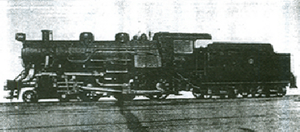Sentetsu Tehoro-class locomotive
The Tehoro-class (テホロ) locomotives were a class of steam tender locomotives of the Chosen Government Railway (Sentetsu) with 4-6-0 wheel arrangement.[1] The "Teho" name came from the American naming system for steam locomotives, under which locomotives with 4-6-0 wheel arrangement were called "Ten Wheeler".[2]
| Chosen Government Railway Tehoro class (テホロ) Korean National Railroad Teou6 class (터우6) Korean State Railway Tŏuyu class (더우유) | |||||||||||||||||||||||||||||||||||||||||||||||||||
|---|---|---|---|---|---|---|---|---|---|---|---|---|---|---|---|---|---|---|---|---|---|---|---|---|---|---|---|---|---|---|---|---|---|---|---|---|---|---|---|---|---|---|---|---|---|---|---|---|---|---|---|
 A Tehoro-class locomotive as built. | |||||||||||||||||||||||||||||||||||||||||||||||||||
| |||||||||||||||||||||||||||||||||||||||||||||||||||
| |||||||||||||||||||||||||||||||||||||||||||||||||||
| |||||||||||||||||||||||||||||||||||||||||||||||||||
| |||||||||||||||||||||||||||||||||||||||||||||||||||
After the Liberation of Korea, of the 178 surviving locomotives of all Teho classes - including six previously owned by private railway companies - 106 went to the Korean National Railroad in the South, and 72 to the Korean State Railway in the North.[3]
Description
Having become indispensable on branchline use, it was decided to modernise the Teho type, and in 1925–26 local engineers developed a derivative locomotive.[1] The result was the テホロ (Tehoro) class, the first of which was built in July 1927 and the second in October of the same year, both at Sentetsu's Gyeongseong Works.[4] These featured a single-stage compressor, and improvements included the expansion of the heat transfer area, improved power transfer and brakes, an automated smoke box door, and other improvements. The Tehoro class was designed for use on both passenger and freight trains, and was used primarily on the Gyeongui and Gyeongbu lines.[1] The next thirteen came in 1929, five from Gyeongseong and four each from Mitsubishi and Hitachi's Kasato works;[1][4] the last of these became the largest producer of Tehoro class locomotives.[1] Another eighteen were delivered in 1937, nine each from Hitachi Kasato and Kawasaki,[1] and in 1938, as part of Sentetsu's general renumbering, the Tehoro class locomotives in service received numbers テホロ1 through テホロ39.[4] Finally, between 1939 and 1941, 56 more were delivered, mostly from Hitachi Kasato.[1]
The Tehoro class was a notable milestone in the history of Korea's railways. As the first type designed and produced entirely by domestic (Korean and Japanese) factories, it gave Japanese and Korean designers extensive experience which was subsequently applied to the development of the Pashishi and Mikasa-class locomotives.[1]
Postwar
Korean National Railroad 터우6 (Teou6) class
The exact dispersal of the Tehoko-class locomotives after the partition of Korea in 1945 and the division of Sentetsu assets in 1947 is uncertain, but at least five went to the South,[4] where the Korean National Railroad designated them 터우6 (Teou6) class [1] and used them until April 1955, when they were replaced by diesel locomotives.[5]
| Number | Last Sentetsu number | Builder | Year | Notes |
|---|---|---|---|---|
| 터우6-23 | テホロ23 | Hitachi Kasato | 1937 | |
| 터우6-25 | テホロ25 | Hitachi Kasato | 1937 | Derelict by 1954.[4] |
| 터우6-32 | テホロ32 | Kawasaki | 1937 | |
| 터우6-82 | テホロ83 | Hitachi Kasato | 1942 | |
| 터우6-93 | テホロ93 | Hitachi Kasato | 1942 |
Korean State Railway 더우유 (Tŏuyu) class
Most of the class went to the North after the partition, where they were designated 더우유 (Tŏuyu) class by the Korean State Railway, but little is known of their service lives and subsequent fates.
Construction
| Year | Builder | Total | Numbers (1927–1938) | Numbers (1938–1945) |
|---|---|---|---|---|
| 1927 July | Gyeongseong | 1 | 751 | テホロ1 |
| 1927 Oct. | Gyeongseong | 1 | 752 | テホロ2 |
| 1929 Mar.-Dec. | Gyeongseong | 5 | 759–763 | テホロ9–テホロ13 |
| 1929 | Hitachi Kasato Mitsubishi | 4 4 | 764–771 | テホロ14–テホロ21 |
| 1937 | Hitachi Kasato Kawasaki | 9 9 | 772–789 | テホロ22–テホロ39 |
| 1939 | Hitachi Kasato | 15 | - | テホロ40–テホロ54 |
| 1940 | Hitachi Kasato | 10 | - | テホロ55–テホロ64 |
| 1941 | Hitachi Kasato Kawasaki | 14 3 | - | テホロ65–テホロ81 |
| 1942 | Hitachi Kasato | 14 | - | テホロ82–テホロ95 |
| Total | 95 |
| Builder | Years | Total |
|---|---|---|
| Gyeongseong | 1927, 1929 | 7 |
| Kawasaki | 1927, 1937, 1941 | 18 |
| Hitachi Kasato | 1929, 1937, 1939–42 | 66 |
| Mitsubishi | 1929 | 4 |
| Total | 95 |
References
- Byeon, Seong-u (1999). 한국철도차량 100년사 [Korean Railways Rolling Stock Centennial] (in Korean). Seoul: Korea Rolling Stock Technical Corp.
- Colvin, Fred H. (1906). The railroad pocket-book: a quick reference cyclopedia of railroad information. New York, Derry-Collard; London, Locomotive Publishing Company (US-UK co-edition). p. L‑9.
- "Korean National RR TW-1 4-6-0". donsdepot.donrossgroup.net.
- "Korean National RR Class TW6 4-6-0s". donsdepot.donrossgroup.net.
- "철또군이 들려주는 이야기 : 네이버 블로그". korail0918.blog.me.